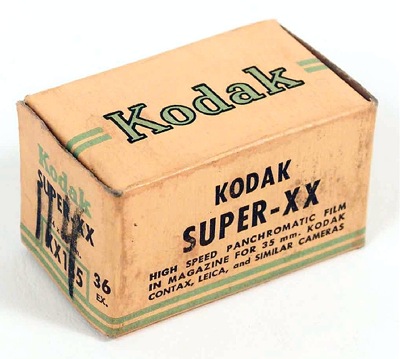 [To mark the 79th anniversary of D-Day — June 6, 1944 — we present the first installment of this five-part Guest Post by military historian Charles Herrick. It results, once again, from the Capa D-Day Project team’s determination to consider all possibilities, follow all leads, answer all pertinent questions and, to the extent possible, tie up any remaining loose ends.
[To mark the 79th anniversary of D-Day — June 6, 1944 — we present the first installment of this five-part Guest Post by military historian Charles Herrick. It results, once again, from the Capa D-Day Project team’s determination to consider all possibilities, follow all leads, answer all pertinent questions and, to the extent possible, tie up any remaining loose ends.
In this series, Herrick pursues further the questions raised by conflicts between Capa’s own account (in Slightly Out of Focus) of his D-Day return trip from the Easy Red sector of Omaha Beach to the USS Samuel Chase (APA-26), which would take him and his films back to England. Capa’s fictionalized version of this passage is a pastiche, combining exaggerated versions of his own experiences with a number of incidents he witnessed from a distance and elements he simply invented out of whole cloth. Delving into the documentation, Herrick reconstructs the timeline of Capa’s departure from the battlefield and transfer to the Chase.
With this series Herrick concludes his contribution to this project, a deconstruction of Capa’s mythification of his D-Day experiences based on detailed analysis of the historical facts of the assault on Omaha Beach, grounded in the military records thereof. A book-length research project in its own right, Herrick’s cumulative efforts represent the only examination in depth of the Capa D-Day myth ever undertaken by a combat veteran with demonstrable expertise in the interpretation of military documents. To date, no one has challenged, much less proved erroneous, any of Herrick’s findings.
Part 1 of Herrick’s analysis appears below. Click here for Part 2. — A.D.C.]
•
Leaving Omaha Beach:
Robert Capa Aboard LCI(L)-94 (1)
In past articles I have examined various phases of Robert Capa’s D-Day experiences, attempting on one hand to establish the factual context while on the other hand seeking to filter out the exaggerations and fabrications. If Capa’s narratives are taken at face value, an exciting, action-packed story unfolds. But a closer look reveals that his stories are often improbable, if not outright impossible, as the reality was generally much different.
At this point there remains just one aspect of Capa’s D-Day adventure left to examine: his departure from Omaha Beach aboard LCI(L)-94 (which stands for Landing Craft Infantry (Large)-94).[1] Let’s see how his description of this phase of his adventure stands up to scrutiny.
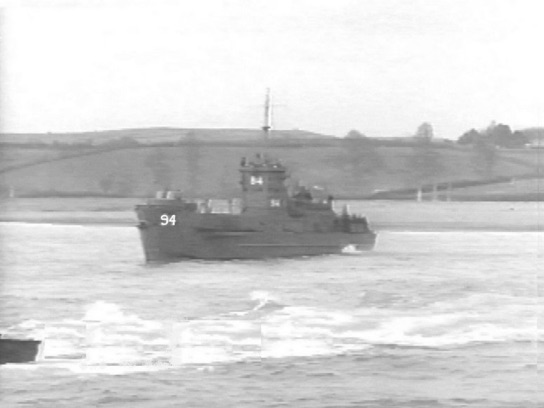
USS LCI(L)-94 off Slapton Sands, England, prior to the Normandy invasion, circa May 1944. (NavSource)
•
Doubts
At the close of a previous post, I pointed out several problems with Capa’s descriptions of boarding LCI(L)-94 and the German shell impact(s) that followed. Let’s take a moment to review those issues.
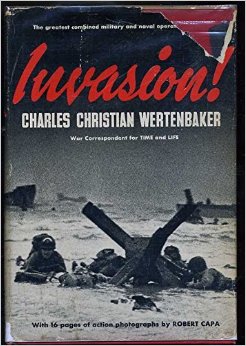
Charles Wertenbaker, “Invasion!” (1944), cover
Capa’s first account of his D-Day experiences was given to LIFE editor and senior correspondent Charles Christian Wertenbaker on June 9 (D+3), after he had returned to Normandy from England:
… Then I climbed aboard and started to change my film. I felt a slight shock and I was all covered in feathers. I thought, “what is this? Is somebody killing chickens?” Then I saw that the superstructure had been shot away and the feathers were the stuffing from the Kapok jackets of the men who were blown up. The skipper was crying because his assistant had been blown all over him and he was a mess. Then things get slightly confused. I was, I think exhausted. An LCVP came for the wounded and I went with them.[2]
Note what he omitted. He made no mention of going down to the engine room (which he did, as evidenced by crew accounts), nor did he mention taking photos (which he did, as evidenced by seven of his pictures, including one taken from within that LCVP).
The second account comes from Capa’s pseudo-biography Slightly Out of Focus, published three years after the invasion:
… I climbed aboard. As I reached the deck, I felt a shock, and suddenly was all covered with feathers. I thought, “What is this? Is somebody killing chickens?” Then I saw that the superstructure had been shot away and that the feathers were the stuffing from the kapok jackets of the men that had been blown up. The skipper was crying. His assistant had been blown up all over him and he was a mess.
Our boat was listing and we slowly pulled away from the beach to try to reach the mother ship before we sank. I went down to the engine room, dried my hands, and put fresh films in both cameras. I got up on deck again in time to take one last picture of the smoke-covered beach. Then I took some shots of the crew giving transfusions on the open deck. An invasion barge came alongside and took us off the sinking boat. The transfer of the badly wounded on the heavy seas was a difficult business. I took no more pictures. I was busy lifting stretchers.[3]
Much of the second version is a word-for-word repetition of the first; no doubt Capa referred back to Wertenbaker’s interview transcript when he penned his own book three years later. But there is also much that is different.
In the second version he didn’t start changing his film as soon as he boarded, nor was that task interrupted by the shell explosion. Instead, the shell hit and then he went below to the engine room to dry off and change film. He also added the “listing and sinking” details. As we saw in that earlier post (“Damage Report”), the “listing and sinking” part was pure fiction, apparently borrowed from the ordeal of a sister ship — LCI(L)-85 — that Capa witnessed later that morning. (Fig. 15)
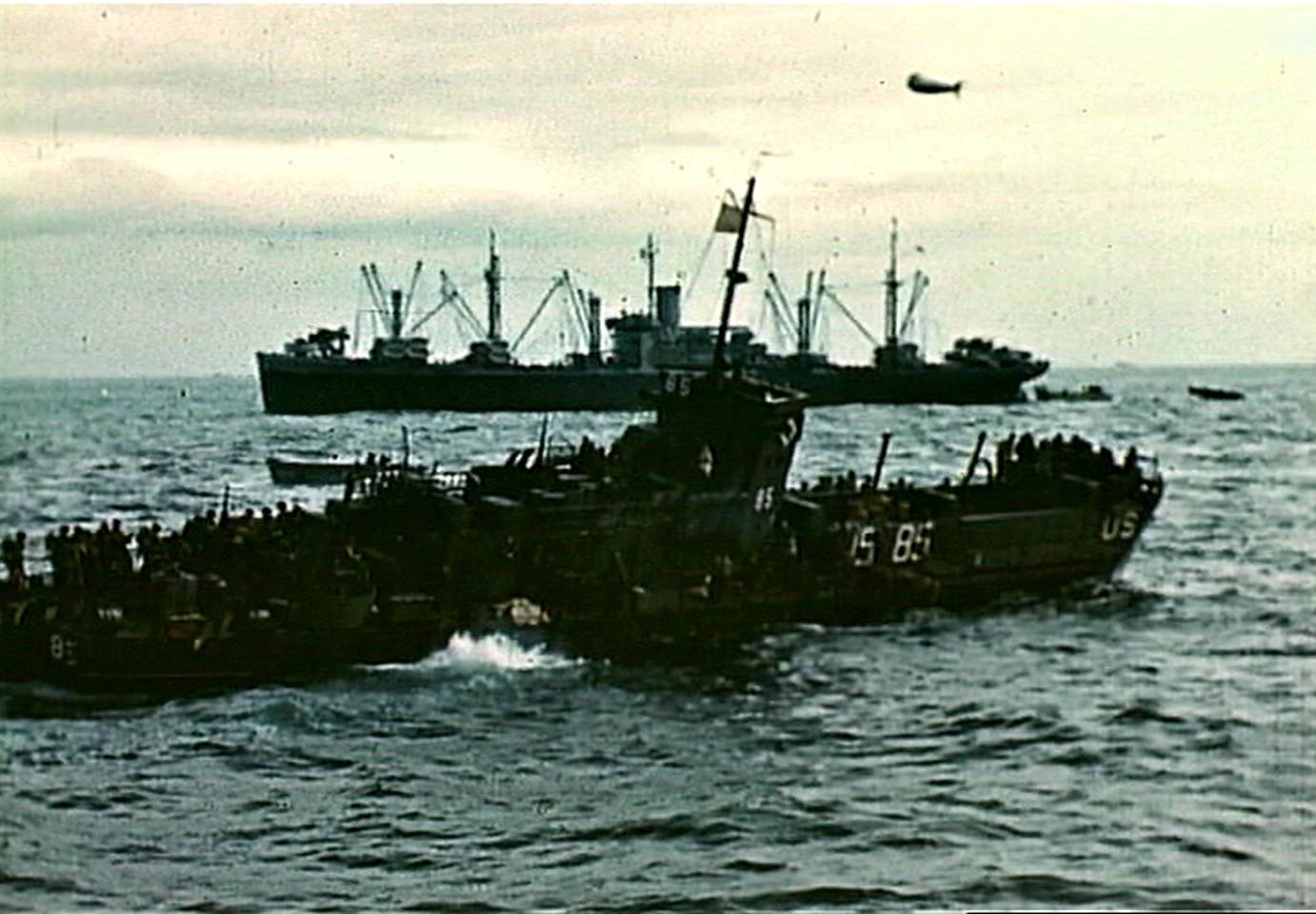
Fig. 15: Fatally damaged LCI(L)-85 returns to USS Samuel Chase, D-Day, frame from film by David T. Ruley
•
So … can any part of his narrative be verified?
Yes. We know that Capa did go to the engine room. Motor Machinist’s Mate 1st Class Clifford Lewis’s duty station during beaching operations was in the engine room. His diary entry for June 6, 1944, included this line: “A Life photographer came aboard our ship from the beach and was soaking wet. He came into the Engine [sic] room to get dry.”[4] Capa was the only LIFE photographer aboard that day, so we can safely assume it was Capa that Lewis saw.
Lewis’s account didn’t mention the part about changing film; perhaps he just didn’t notice Capa doing it, or perhaps Capa didn’t change film because he had no fresh film left.[5]
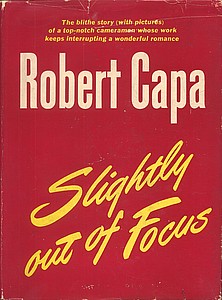
Robert Capa, “Slightly Out of Focus” (1947), cover.
Capa’s presence in the engine room and his attention to his film were also verified by Motor Machinist’s Mate 1st Class Niles West. He recounted, “I remember Capa coming down to the engine room to dry his film, so nervous he was smoking cigarettes in both hands.”[6] The detail of Capa’s nervousness and two-fisted smoking tends to support Capa’s admission of blind panic in Slightly Out of Focus. (“I paused for a moment. And then I had it bad. … I did not think and I did not decide. I just stood up and ran for the boat.”[7])
But the Wertenbaker interview did not mention panic, instead attributing his leaving the beach to running out of film. So Capa’s motivation for flight isn’t certain. Since West’s account came 50 years after D-Day, we cannot exclude the possibility that his distant memories of the encounter were colored by reading some version of Capa’s well-known account in Slightly Out of Focus.
Neither Lewis’s nor West’s account is sufficiently detailed to conclude whether Capa actually changed film or not — and, ultimately, it may not matter. But they do confirm that he did seek shelter in the engine room.
•
One detail that neither account pins down is exactly when Capa came down to the engine room. This omission is likely due to the isolated environment in the engine room, which normally just received and responded to engine-related commands from the bridge without greater context. The crew there simply did not have much awareness of what was going on above decks.
From Lewis’s diary, for example, it is clear that he was unaware the ship had made two separate landings within 15 or 20 minutes that day. (More on this point later.)
We can also confirm that Capa took two (not one) last pictures of the smoke-covered beach, and two photos of the crew rendering medical aid to a mortally wounded casualty (Seaman 1st Class Jack DeNunzio). He also took two additional photos of invasion craft off the beach, although he omitted these from his narrative.
And there is at least an element of truth to his claim that he “was busy lifting stretchers,” though he exaggerated his effort. A photo he took from within that LCVP[8] shows that he watched the sailors struggling with the difficult task of passing the stretcher down from the LCI to the rear deck of the LCVP.
Chief Photographer’s Mate David T. Ruley (a US Coast Guard cameraman aboard LCI(L)-94) also captured this scene in a film clip. In that clip, Capa appeared coming from the bow of the LCVP — where he took his photo — just in time to help lower the stretcher the last three feet into the well of the LCVP. (Fig. 14) Ruley’s film also shows that the LCVP contained just a single stretcher. Again, there was a kernel of truth to Capa’s narrative; the rest was exaggeration.
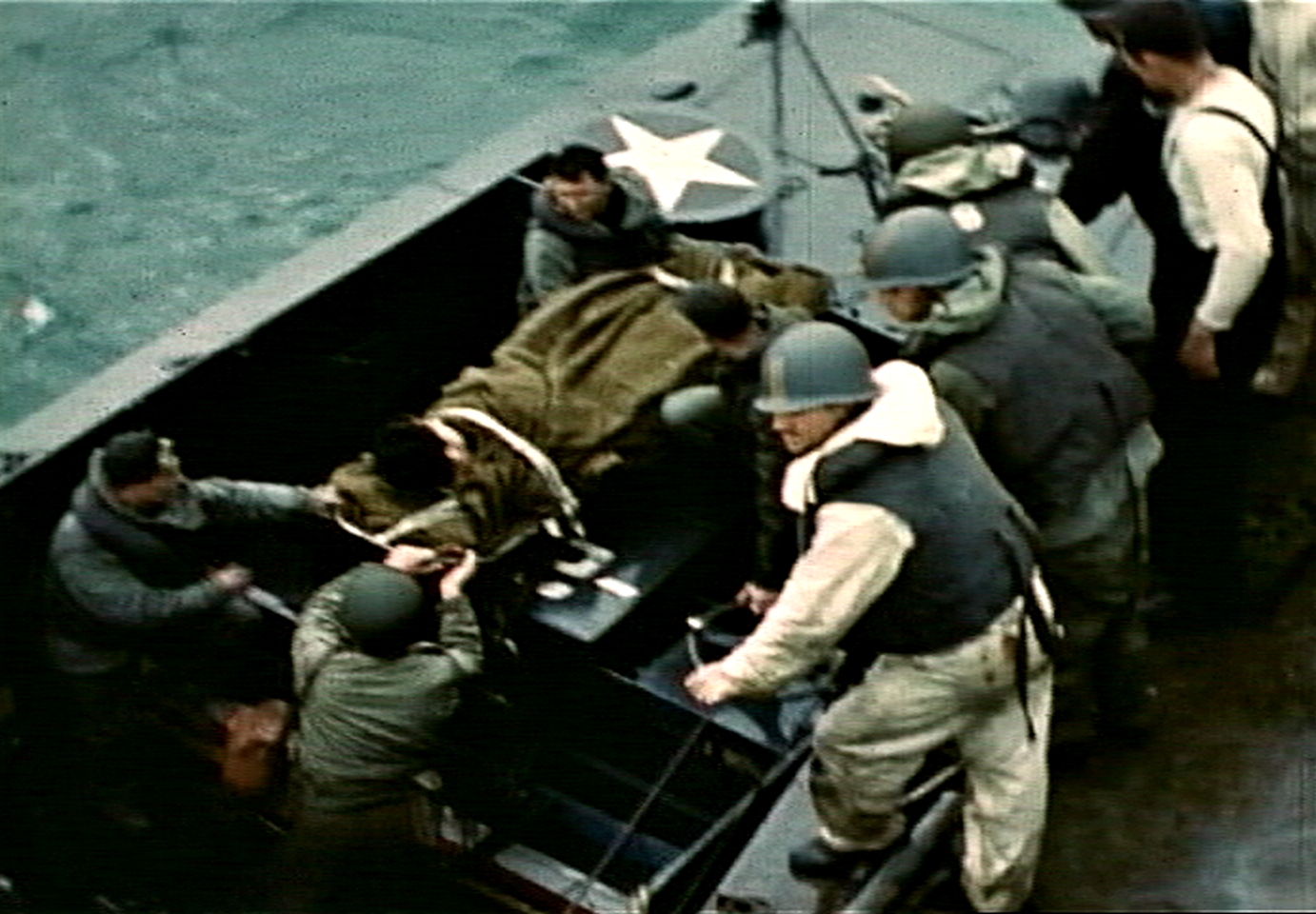
Fig. 14: Robert Capa, bottom left, aboard LCVP from USS Samuel Chase, assisting with transfer of casualty, D-Day, frame from film by David T. Ruley
•
So those parts of Capa’s accounts can be verified. That still leaves several points that simply do not fit.
- Capa’s description of the ship being hit cannot be credited. He described it only as a single “slight shock,” or, in his later account, simply a “shock.” The first problem is that the ship was hit at least twice (and perhaps three times), not just once. And, if he had just boarded when those hits occurred, he would have been on the main deck within just a few yards of the points of impact on the superstructure. As a result, the impacts would have been, as they say, an intensely personal and emotional experience, rather than a mere “slight shock.”
- Nor does his claim of being covered in kapok debris make sense. Pictures of the crew trying to save the life of DeNunzio on the boat deck do show a limited area (8-10 feet in diameter) littered by kapok debris from DeNunzio’s life vest. But if he had just boarded, Capa would have been outside the kapok debris field, a deck below, and probably with the pilothouse interposed between the kapok debris and his location. In other words, he couldn’t have been covered in those “feathers.” It just doesn’t fit. (In the “Damage Report” post I posit the possibility that the kapok came instead from a shell shredding a “Carley float,” a standard life raft with several of which LCI(L)-94 was equipped.)
- Similarly, Capa’s description of the captain being covered in the blood of his “assistant,” who had been “blown up all over him,” is clearly wrong. The captain was up on the open conning station, and not in a position to be covered in gore from an explosion a deck below in the pilot house or from an explosion on the boat deck. The vignette simply could not have played out as Capa portrayed it. Furthermore, Capa, whose route to safety went from the main deck to the engine room, would not have been in a position to observe the captain’s emotional or physical state two decks above him.
- And finally, there is the matter of Capa’s immersion. As he waded out to board the LCI, he wrote, “… and the water reached up to my neck. The rip tide hit my body and every wave slapped my face under my helmet.”[9] He was, quite literally, drenched from head to toe. The significance of this “drenched from head to toe” detail will soon become apparent. …
Notes:
[1] See Addendum 1 for an explanation of D-Day landing craft and their characteristics.
[2] Wertenbaker, Charles, Invasion!, D. Appleton-Century Co., Inc., New York, 1944, pp. 42-44.
[3] Capa, Robert, Slightly Out of Focus, 2001 edition, Modern Library, New York (originally published in 1947), pp. 148-149. All subsequent references are to this edition of the book.
[4] Lewis, Clifford, Excerpts From WWII Diary of Clifford W. Lewis, MoMM 1/C, United States Coast Guard. US Coast Guard Historian’s Office (https://media.defense.gov/2021/Dec/15/2002909575/-1/-1/0/NORMANDY_DIARY.PDF )
[5] This is a confusing point. Earlier in the Wertenbaker interview Capa claimed he left the beach because he had run out of fresh film after shooting two rolls and ruining a third. Yet in both accounts he claimed he changed film once aboard the LCI, going so far in Slightly Out of Focus to state “… and I put fresh films in both cameras,” referring to the two Contax cameras he said he used on the beach. The evidence, however, indicates that he used his Rolleiflex camera from that point on for the rest of D-Day, limiting the remainder of his D-Day coverage to what amounted to a single pack of 12 exposures. This would tend to indicate he had no fresh film for his Contax cameras.
[6] American Heritage, Sept. 1994, Vol. 45, no. 5, “Letters to the Editor,” p. 8.
[7] Slightly Out of Focus, p. 148.
[8] This photo is held in the archives at the International Center of Photography (2010.90.2107) as part of the Robert Capa and Cornell Capa Archive. I discovered it while conducting research at the ICP in 2019. It is not in their online database, has not been released for public display, and has not been previously published. Nor do I have permission to use it here. One has to wonder whether there are any other undiscovered photos in that archive.
[9] Slightly Out of Focus, p. 148.
•
Text copyright © 2023 by Charles Herrick. All rights reserved.
•
(For an index of links to all posts in this series, click here.)
•
 Charles Herrick joined the U.S. Army in 1970 and graduated from the U.S. Military Academy at West Point in 1974. Commissioned in the Infantry, he earned the Ranger tab and Master Parachutist’s wings. He served in a variety of positions from company grade officer to the Pentagon. He earned the Combat Infantryman’s badge while assigned as the Operations Officer of the 193rd Infantry Brigade in Panama in 1989, and later graduated from the U.S. Army War College.
Charles Herrick joined the U.S. Army in 1970 and graduated from the U.S. Military Academy at West Point in 1974. Commissioned in the Infantry, he earned the Ranger tab and Master Parachutist’s wings. He served in a variety of positions from company grade officer to the Pentagon. He earned the Combat Infantryman’s badge while assigned as the Operations Officer of the 193rd Infantry Brigade in Panama in 1989, and later graduated from the U.S. Army War College.
Since retiring from the Army in 1996, Herrick has continued to work on defense issues as a contractor in East Asia, Latin America, the Balkans, Africa and Central Asia. He holds an MBA from the University of California at Los Angeles. He lives in California with his wife, where he pursues his passion for military history. To contact Charles Herrick, click here.






Leave a Comment